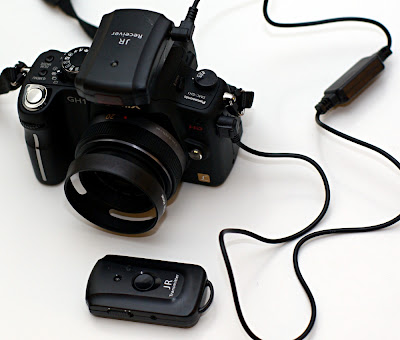Using macro rings has always been a cheap trick to improve the close focusing distance of a lens. You'll notice that when focusing from infinity to a closer distance, the lens elements usually move away from the camera and the sensor. Some exceptions from this are lenses with internal focusing, or back focusing.
So what happens if you move the lens even further from the camera than what's possible with the focus ring? It turns out that this gives you an even closer focus. So what a macro extension ring simply does, is allow you to mount the lens further from the sensor, translating the focus range of the lens so that it can be used for close up work.
There are no macro rings officially available for the Micro Four Thirds mount yet. However, when using legacy lenses on an adapter, there are a wide range of macro rings to try out. Here is a set of Nikon macro rings from Jessop:

These rings contain some mechanical coupling functions to allow for the aperture information to be transfered to the camera, and for the camera to automatically stop down the lens before taking a picture. However, these functions only work on AIS capable cameras. In today's Nikon lineup, only the top models have retained this functionality.
When using the rings on a crude adapter, you can certainly forget about this functionality. You'll need to focus using a large aperture, and then alter the aperture ring manually prior to pressing the shutter release, if you want to stop down the aperture.
The thickness of the rings are 13mm, 21mm, and 31mm. When stacked in different combinations, they can give these offset distances: 13mm, 21mm, 31mm, 34mm, 41mm, 52mm and 65mm.
Normally, these rings would go between the camera mount and the lens. When using an adapter, however, they go between the adapter and the lens, as in this picture:

A
Nikon-Micro Four Thirds adapter (marked with "Nik-M4/3") is mounted to the
Panasonic Lumix GH1 camera, and all the macro rings are stacked between the lens and the adapter. The lens is a Nikkor 50mm f/1.8 AIS.
Here is a video showing how to attach the adapter and lens to the camera.
When using all the macro rings above, I took this picture of a measure band, to find the largest magnification. It was taken at 4/3 aspect ratio, in which case the active sensor is 18mm wide. Since the photographed item is 13mm wide, this gives an enlargement of 18:13, or 1.4:1. This could also be expressed as 1.4x.

For comparison, the
Panasonic Leica DG Macro-Elmarit 45mm f/2.8 macro lens is capable 1:1 enlargement (1x), which means that the largest enlargement possible would have yielded 18mm of the measurement band. The macro rings and Nikkor 50mm lens can be used to make more enlargement than the dedicated Panasonic Leica macro lens.
Using the configuration above, with 65mm extension of the lens, I was able to take this close up picture:

I stopped down the aperture to f/8 for more depth of field.
For comparison, I photographed the same object using the
Olympus Zuiko 50mm 1:2 macro lens. This is the closest picture I could take with the Olympus lens, also at f/8, and with an enlargement of approximately 1:2:

Macro rings for legacy mounts can be bought cheaply on various auction sites. There are also extension tubes and bellows, which are functionally similar, but more flexible in use. Another way to achieve closer focusing is to use a
reverser ring, essentially a second lens mount to be screwed into the front lens filter thread. Using a reverser ring, the lens can be mounted reversed, in which case it can be used for macro. Lenses with a normal focal length are most commonly used this way.
Please note that macro lenses are special in that the lens formula is designed for close up photography. Using ordinary lenses on extension rings or bellows is not going to give as good results, since those lenses are not designed for close focusing.
Here is another example picture using the full 65mm macro ring extension:

For this picture of a garlic, I used f/22 to achieve enough depth of field. Using such a small aperture is going to give some blurring at pixel level due to diffraction. However, in this case, I valued more depth of field higher than some dullness at the highest magnification. The diffraction effect is barely visible at 100% view.
 Here it is very apparent that the Pentax has a more useful exposure. The Panasonic exposure appears to be designed to avoid blown highlights, while the Pentax exposure puts more weight on preserving details in the shadows.
Here it is very apparent that the Pentax has a more useful exposure. The Panasonic exposure appears to be designed to avoid blown highlights, while the Pentax exposure puts more weight on preserving details in the shadows.














